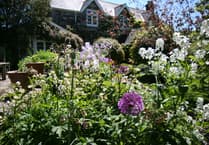A RARE species of birch tree has been located in the wild of the Caucasus mountains of Georgia by a botanist from Stone Lane Gardens in Chagford.
In September, a combined British and Georgian conservation team, led by Paul Bartlett, of Stone Lane Gardens, travelled into the mountains of north west Georgia, searching for the rare birch Betula megrelica.
Known only from plants growing in Russia and UK botanical gardens, the original plants of this species of small shrubby birch had been collected from the wild in Georgia in 1971. However, no precise details of their location had been recorded and the collectors had since died.
Paul said: 'I am delighted with the outcome of the trip. Stone Lane Gardens is one of just a handful of national collections of birch trees in the UK, and having researched these trees for many years, I felt I was well placed to find these trees in the wild.
'By finding Betula megrelica in the wild, I am now able to fully appreciate the way in which it grows, the terrain and geology that creates its habitat, the human and environmental factors that have stopped its spread. While it thrives and is master of the niche habitat in which it lives, in Georgia this habitat is very rare.'
The expedition had financial support from the Rufford Foundation and the Devon group of Plant Heritage and the backing of Queen Mary University of London and the Georgian Institute of Botany.
Paul was able to enlist the help of staff at Tbilisi Botanic Garden. The team then employed three local guides to help with transportation and navigation in the mountains of the Samegrelo region.
Using a battered six-wheel Russian truck, the team gained access to Mount Migaria, where they set up base camp. They then explored the mountain and its neighbouring Mount Jvari, finding Betula megrelica in large numbers on the steep north facing slopes of both mountains.
Plants lower down the faces had been grazed by domestic goats and cows, but higher up, among the steep gullies and crags, the trees were growing healthily, forming dwarf woodland between the cliffs.
Paul made many observations of the birch woodland from the base of the cliffs to its upper limits just below the mountain summits. A great deal of seed was collected, and this will be studied and propagated by both Tbilisi Botanic Garden in Georgia and back at Stone Lane Gardens. Samples of wood material was packed for shipping back to the UK.
Back in England, the plant sciences department of Queen Mary University of London used state-of-the-art equipment to analyse the molecular structure of the wood material, which was found to match that of Betula megrelica, thus proving the existence of stable wild populations of the rare birch in Georgia.
Stone Lane Gardens holds national collections of birch and alder trees, and is open seven days a week throughout the week. For more information visit http://www.stonelanegardens.com">www.stonelanegardens.com or call 01647 231311.



.jpeg?width=209&height=140&crop=209:145,smart&quality=75)